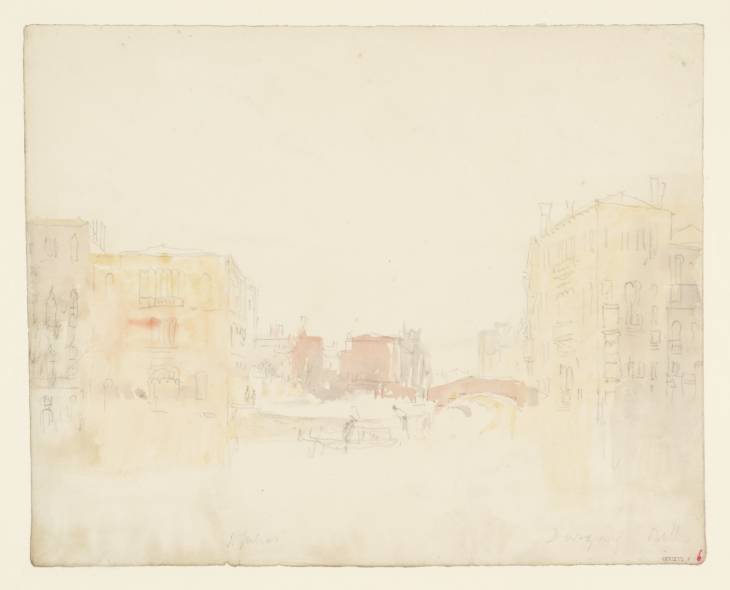Joseph Mallord William Turner The Campo San Vio from the Grand Canal, Venice, between the Palazzo Barbarigo and the Palazzi Loredan-Cini and Balbi Valier 1840
Joseph Mallord William Turner,
The Campo San Vio from the Grand Canal, Venice, between the Palazzo Barbarigo and the Palazzi Loredan-Cini and Balbi Valier
1840
Joseph Mallord William Turner 1775–1851
The Campo San Vio from the Grand Canal, Venice, between the Palazzo Barbarigo and the Palazzi Loredan-Cini and Balbi Valier 1840
D32143
Turner Bequest CCCXVI 6
Turner Bequest CCCXVI 6
Pencil and watercolour on white wove paper, 246 x 307 mm
Inscribed by Turner in pencil ‘St [?Julian]’ towards bottom left, and ‘D[...] Balbi’ bottom right
Inscribed in red ink ‘6’ bottom right
Stamped in black ‘CCCXVI 6’ bottom right
Inscribed by Turner in pencil ‘St [?Julian]’ towards bottom left, and ‘D[...] Balbi’ bottom right
Inscribed in red ink ‘6’ bottom right
Stamped in black ‘CCCXVI 6’ bottom right
Accepted by the nation as part of the Turner Bequest 1856
References
1909
A.J. Finberg, A Complete Inventory of the Drawings of the Turner Bequest, London 1909, vol.II, p.1018, CCCXVI 6, as ‘View in Venice. – “St. Julias – Dargang (?) – Balbi (?).”’.
1930
A.J. Finberg, In Venice with Turner, London 1930, p.173, as ‘View in Venice’, 1840.
2003
Ian Warrell in Warrell, David Laven, Jan Morris and others, Turner and Venice, exhibition catalogue, Tate Britain, London 2003, pp.156, 164, 259, fig.176 (colour), as ‘The Campo San Vio from the Grand Canal, with the Palazzo Loredan-Balbi on the right and the Palazzo Barbarigo on the left’, 1840.
The viewpoint is off the Casa Succi at the entrance to Rio del Santissimo, looking south-south-west across the Grand Canal and along the Campo San Vio, with the Rio di San Vio to its right. At the far left is part of the Palazzo Da Mula Morosini, with the adjoining Palazzo Barbarigo beside the square; its façade since has been decorated with elaborate mosaics. On the right are the Palazzo Loredan-Cini and the first two bays of the Palazzo Balbi Valier. The setting was identified by Ian Warrell,1 who has noted it as a relatively rare case in Turner’s work of Grand Canal frontages seen head-on in the manner of the systematic elevations presented in Dionisio Moretti’s 1820s Prospetto del Canal Grande di Venezia engravings, rather than receding in conventional perspective along both sides.2
Turner’s inscriptions are somewhat elusive. The first seems to be ‘St Julian’ or ‘Julias’; there is a church of San Zulian (sic) elsewhere in the city, north of the Piazza San Marco (St Mark’s Square). The second, towards the bottom right, Finberg tentatively read as ‘Dargang’,3 and while it may be that the middle letter is rather ‘z’, the word and its significance still remain obscure. Only the last, ‘Balbi’, has a clear relationship to the identified buildings. The subject defeated Finberg, and he annotated his 1909 Inventory entry (‘View in Venice. – “St. Julias – Dargang (?) – Balbi (?).”’), crossing out ‘Balbi’ and adding ‘on a side canal’, rather hesitantly placing the subject in the north of the city: ‘? Dardano. [?nr] Ponte Turlona | in Cannaregio’.4
The buildings at the far end of the square are washed in with economically rendered but atmospheric shadow against the contre-jour light of early afternoon, while the scene is enlivened by the introduction of a handful of figures and a gondola; there is a sense of the canalside buildings catching some reflected light from the water. Tate D32138 (Turner Bequest CCCXVI 1), also in this subsection, shows the view east towards Santa Maria della Salute and the canal’s Bacino entrance from about the same viewpoint. Warrell has observed that both subjects are ‘pervaded by a radiant afternoon sunlight ...Watercolour is not used merely to describe form, but also to represent the shadows by which from is defined.’5
Technical notes:
This is one of numerous 1840 Venice works Ian Warrell has noted as on sheets of ‘white paper produced [under the name] Charles Ansell,1 each measuring around 24 x 30 cm, several watermarked with the date “1828”’:2 Tate D32138–D32139, D32141–D32143, D32145–D32147, D32154–D32163, D32167–D32168, D32170–D32177, D35980, D36190 (Turner Bequest CCCXVI 1, 2, 4–6, 8–10, 17–26, 30, 31, 33–40, CCCLXIV 137, 332). Warrell has also observed that The Doge’s Palace and Piazzetta, Venice (National Gallery of Ireland, Dublin)3 and Venice: The New Moon (currently untraced)4 ‘may belong to this group’.5
Albeit Peter Bower, Turner’s Later Papers: A Study of the Manufacture, Selection and Use of his Drawing Papers 1820–1851, exhibition catalogue, Tate Gallery, London 1999, p.81, notes that the Muggeridge family had taken over after 1820, still using the ‘C Ansell’ watermark.
Verso:
Blank; stamped in black ‘CCCXVI – 6’ over Turner Bequest monogram below centre; inscribed in pencil ‘D32143’ bottom left, and ‘AB148 | [...]’ bottom right.
Matthew Imms
September 2018
How to cite
Matthew Imms, ‘The Campo San Vio from the Grand Canal, Venice, between the Palazzo Barbarigo and the Palazzi Loredan-Cini and Balbi Valier 1840 by Joseph Mallord William Turner’, catalogue entry, September 2018, in David Blayney Brown (ed.), J.M.W. Turner: Sketchbooks, Drawings and Watercolours, Tate Research Publication, December 2019, https://www

